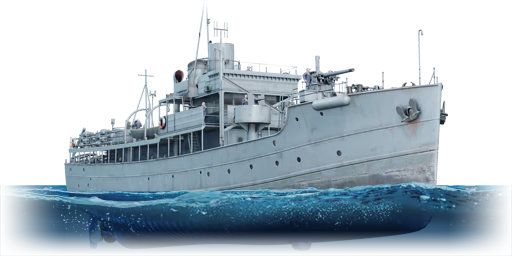



The HMS Liscomb (T285) was one of 197 British Isles-class naval trawlers. This class of coastal minesweeper and minelayers was designed in 1939, based on fishing trawler designs, to simplify and hasten production to fulfil coastal patrol duties. They were also easily converted back into civilian trawlers and sold off once the war was over. Like the larger Flower-class corvettes (which shared a similar improvised design), a large number of Isles-class ships were built in Canada to guard the vast coastline of the British Empire.
HMS Liscomb was built by the Kingston Shipyard in Ontario, Canada, to the Dance -subclass specifications. Liscomb was commissioned on 3 September 1942 and loaned to the Royal Canadian Navy. She served uneventfully until the end of the war. She was later decommissioned in 1945 and sold to a Norwegian trawler company a year later, who renamed her Aalesund. Her final fate, however, remains unknown.
Introduced in Update 1.83 "Masters of the Sea" as part of the British fleet Closed Beta Test, the Liscomb is an absurdly tough coastal vessel, especially for her BR, thanks to her detailed damage model which allows her to shrug off any machine guns and most autocannons she commonly faces. However, she has a figurative "Achilles' heel" in the form of an extremely vulnerable ammo rack. In addition, her mobility is among the worst of any coastal vessel, which, combined with her large size, makes her highly vulnerable to torpedoes and artillery strikes. On the other hand, Liscomb has access to reasonably powerful armament to support allies. Because of this, the Liscomb is best suited as a "bullet sponge", capable of taking numerous hits as long as her ammo racks are not exposed, though she would often need some escort to guard her vulnerable sides.
| Ammunition | Type | Armor penetration (mm) at a distance: | |||||
|---|---|---|---|---|---|---|---|
| 10 m | 100 m | 500 m | 1000 m | 1500 m | 2000 m | ||
| HE | 11 | 11 | 11 | 11 | 11 | 11 | |
| SAP | 91 | 77 | 63 | 54 | 49 | 42 | |
| Shrapnel | 6 | 6 | 6 | 6 | 6 | 6 | |
| Belt | Belt filling | Armor penetration (mm) at a distance: | |||||
|---|---|---|---|---|---|---|---|
| 10 m | 100 m | 500 m | 1000 m | 1500 m | 2000 m | ||
| HEF-T/HEF-I/AP-T | 34 | 32 | 26 | 21 | 18 | 16 | |
| AP-T/AP-T/AP-T/HEF-I | 34 | 32 | 26 | 21 | 18 | 16 | |
| HEF-T/HEF-I/AP-T/HEF-I | 34 | 32 | 26 | 21 | 18 | 16 | |
| Belt | Belt filling | Armor penetration (mm) at a distance: | |||||
|---|---|---|---|---|---|---|---|
| 10 m | 100 m | 500 m | 1000 m | 1500 m | 2000 m | ||
| AP/T | 10 | 9 | 8 | 7 | 6 | 5 | |











Seakeeping |
|---|
Unsinkability | |
|---|---|
Firepower | ||
|---|---|---|